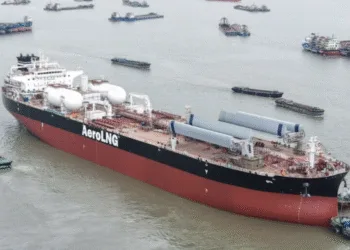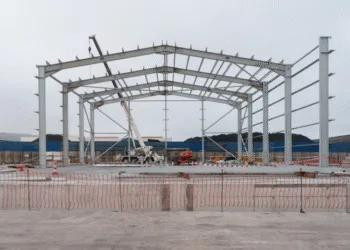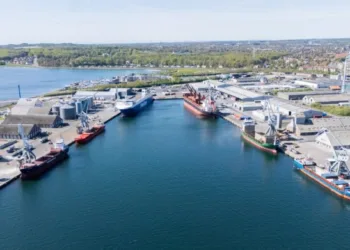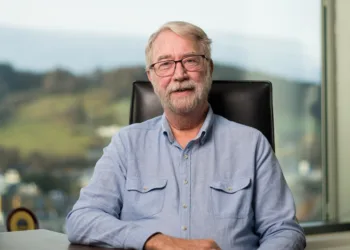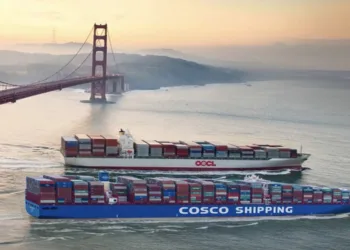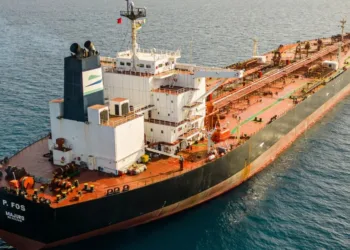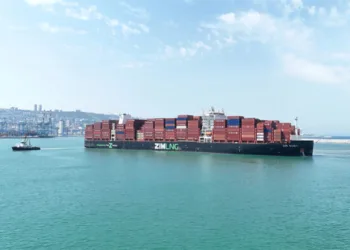At last week’s Maritime CEO Forum held at the Fullerton Hotel in Singapore, a high-level panel explored one of the most pressing questions in shipping today: as artificial intelligence and digitalisation transform the sector, how can the workforce adapt, upskill, and thrive in a human-centred maritime future?
The discussion, moderated by Mark Charman, CEO and founder of Faststream Recruitment, drew contributions from Marco Camporeale, vice president at Inmarsat; Su Yin Anand, partner at IBM Consulting and co-founder of The Captain’s Table; Vikas Trivedi, co-CEO of shipmanagement at Synergy Marine Group; and Vinod George, general manager of operations at CMB.TECH.
Charman opened the session with characteristic energy, framing the debate around the reality that AI is no longer science fiction. He highlighted data from the World Economic Forum’s Future of Jobs Report, noting that globally, by 2030, 170m new jobs will be created and 92m lost – a net increase of 78m. “Technology, automation, and AI are going to shape our future landscape, and it will have a huge impact on the maritime sector,” he said.
To set the scene, Charman asked the audience whether AI would create more maritime jobs than it eliminates. The show of hands revealed caution: many expected a reduction in jobs, though others predicted status quo or modest gains.
Marco Camporeale of Inmarsat stressed that AI is primarily a bridge between ecosystems. “On ships, the impact of AI will be to connect operations more efficiently, streamline intelligence, and assist crew in making smart decisions, whether in navigation, technical operations, sustainability, or compliance,” he said. Camporeale emphasised that AI will support decision-making, incident response, and training, but the human element remains essential. “We need to have the right balance as of today,” he said.
Su Yin Anand highlighted the growing demand for digitally literate, data-literate, and tech-savvy crew. “Ships are now highly connected with IoT sensors and real-time data links. This shifts the demand towards more tech-enabled, data-driven operations,” she said. Anand explained that seafarers increasingly need to interpret dashboards, troubleshoot onboard systems, and maintain cybersecurity. “High-tech ships are transforming the ratio of crew attention from physical operations to computer-based tasks. Technical proficiency for the remaining crew is increasing, even as some roles are reduced.”
Charman and the panel agreed that the human workforce remains central. “In our survey of senior maritime executives, 61% said AI is their number one personal development priority. Two years ago, it was all about ESG and sustainability,” Charman said. The panel highlighted that 68% of executives now use AI in their daily work, up from 26% two years ago.
Anand stressed the importance of upskilling for an AI-driven future. “We need to start by understanding the business in five years and what skill sets will be needed,” she said. “You shouldn’t recruit for skills that will be out of fashion in two or three years. Employees need to feel comfortable using AI, seeing how it augments productivity rather than replacing jobs. Management support is critical – if leaders aren’t comfortable with AI, it will never be adopted effectively.”
Vikas Trivedi focused on the human dimension. “AI works with you as a co-worker, not just a productivity tool. As AI takes over repetitive tasks, we need to focus more on what it means to be human in the workplace,” he said. Trivedi stressed the importance of non-technical skills, such as situational awareness and problem-solving, when technology fails. “Your HR policies now have to govern a workforce combined with AI. Are we thinking enough about social and cultural development at work?”
Anand raised a critical concern: overloading crews with data can exacerbate fatigue and reduce situational awareness, increasing the risk of maritime incidents. “Human error is the major cause of maritime accidents, and throwing more data at the crew without considering its impact on cognitive load is a serious risk,” she said.
Vinod George echoed the need for crew involvement in technology adoption. “Do we really take crew input when designing these systems? AI and cameras are being deployed on ships, but if the crew isn’t consulted, adoption suffers. The IMO is reactive – rules come after incidents. We can’t expect AI to replace human judgment,” he said. George highlighted practical examples, such as automated draft readings, which still require human verification, illustrating the tension between automation and regulatory compliance.
Trivedi argued that while AI may replace repetitive jobs, it largely augments human capabilities. “Automation can’t run an organisation entirely on AI because of risk. Implementation creates new roles as well as efficiencies,” he said. Camporeale reinforced that AI primarily aids documentation, training, and operational support rather than eliminating crew.
Panellists also addressed the slow pace of regulatory adaptation. “STCW hasn’t changed much, despite rapid technological advances,” George said. “Ship design and digitalisation often outpace training and safety protocols. We’re in 2025, yet some ships still use outdated equipment without safety safeguards.”
The discussion also touched on the challenge of attracting talent. “Modern maritime recruits ask how many days they can work from home,” George said. “To make seafaring attractive, we need to invest in crew training, welfare, and technology, demonstrating that shipping is a modern, innovative career.”
Charman highlighted a persistent issue: maritime recruitment remains overwhelmingly male, with less than 5% female hires in the past year. Anand called for broader perspectives, both gender and external, to accelerate innovation. “As we think about decarbonisation and AI, external perspectives are critical. I urge women in the room to volunteer for panels – we need diverse voices,” she said.
When asked what shipping companies should do today, Camporeale emphasised the need for trust and solid seamanship alongside technology. “We need humans to make judgment calls. AI should support, not replace, human intelligence,” he said. Trivedi urged companies to transform core functions and mindsets before automating roles. George stressed clear top-down investment decisions, from people to technology, as essential for effective digitalisation.
Connectivity was another priority. Anand noted that uninterrupted, reliable data links are mission-critical for AI and operational systems. “Even one hour offline can compromise performance. Cheaper connectivity policies are no longer acceptable,” she said.
Audience members raised the role of generational familiarity with technology. One delegate noted, “Children today grow up with AI and digital tools as a sixth sense. We need to trust the new generation to leverage AI intuitively.” Another highlighted the challenge of imagining the “unimaginable,” with technology evolving faster than regulatory and corporate structures can respond.
Fatigue and social media distractions were also discussed. Anand explained that some companies, even with unlimited connectivity, limit crew internet usage to maintain focus and rest periods. “Trusting individuals to manage their own off-duty time is crucial,” she said.
The panel concluded on a note emphasising balance. AI and digitalisation are transforming the maritime workforce, but human judgment, situational awareness, and proactive upskilling remain vital. Diversity of thought, generational inclusion, and careful management of cognitive load are essential for a safe and productive industry.




